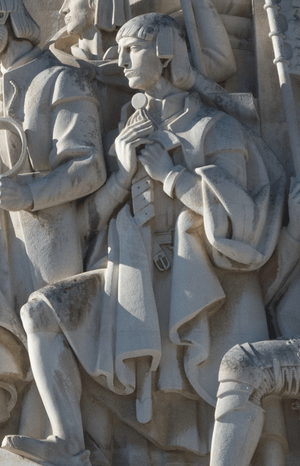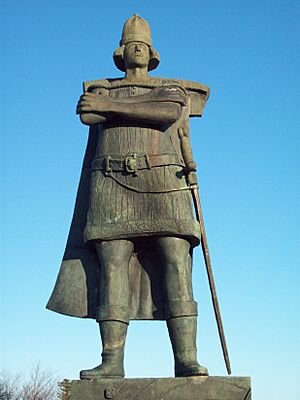Gaspar Corte-Real facts for kids
Quick facts for kids
Gaspar Corte-Real
|
|
|---|---|

|
|
| Born | 1450 Angra do Heroismo, Terceira, Azores Islands, Kingdom of Portugal
|
| Disappeared | 1501 Unknown |
| Nationality | Portuguese |
| Citizenship | Kingdom of Portugal |
| Occupation | Navigator, explorer, & slave trader |
| Known for | Exploring the North American coast |
| Parent(s) |
|
Gaspar Corte-Real (born 1450 – disappeared 1501) was a Portuguese explorer. He went on many voyages to explore new lands. His father, João Vaz Corte-Real, and his brother, Miguel, were also explorers. They were supported by the King of Portugal. Some historians believe their trips were among the first to reach Newfoundland and parts of eastern Canada.
Contents
Early life and family
Gaspar was born in 1450 on Terceira. This island is part of the Azores Islands. His family, the Corte-Real family, was well-known. He was the youngest of three sons. His father, João Vaz Corte-Real, was also an explorer. Gaspar joined his father on trips to North America. His brothers also became explorers.
Exploring new lands
In 1498, King Manuel I of Portugal became very interested in exploring lands to the west. He thought that the lands John Cabot had recently found (the coast of North America) might belong to Portugal. This was based on an agreement called the Treaty of Tordesillas. Gaspar Corte-Real was one of the explorers who sailed west for Portugal.
In 1500, Corte-Real reached Greenland. He thought it was east Asia, much like Christopher Columbus believed about the New World. However, he could not land there. The seas were too frozen.
He started a second voyage in 1501 with three ships called caravels. Again, they could not land in Greenland because of the ice. So, they changed direction. They landed in a place with big rivers, pine trees, and berries. This place is thought to be Labrador. Here, they captured 57 indigenous people. These people were taken back to Portugal. They were sold to help pay for the trip. Two of the three ships returned to Portugal. But the ship carrying Gaspar Corte-Real was lost at sea.
No one ever heard from Gaspar Corte-Real again after 1501. His brother Miguel went looking for him in 1502. Sadly, Miguel also disappeared.
Gaspar Corte-Real's legacy

Historians have different ideas about how important Gaspar Corte-Real was. Some, like Jeff Webb from Memorial University of Newfoundland, say that "very, very little is known with confidence" about him. Much of the information about Corte-Real in the 20th century came from a historian named Eduardo Brazao. He worked for Portugal's government propaganda office.
A statue of Corte-Real was put up in 1965 in St. John's, Newfoundland and Labrador. It stands in front of the Confederation Building. There has been some discussion about this statue recently. A street in Mount Pearl is named after him. Also, a building at Memorial University of Newfoundland was once named after him. In 2019, the university decided to change its name to the Global Learning Centre.
The St. John's statue
The statue of Corte-Real in St. John's was a gift from a Portuguese fishing group in 1965. It was meant to celebrate how welcoming people from Newfoundland were to Portuguese fishermen.
In 1999, a car hit the statue's base, but the statue itself was not damaged. It was later repaired and returned to its original look.
In 2020, people started talking about the statue again. It was noted that the statue was put up during a time when Portugal and Spain were arguing over fishing rights. Newfoundland and Labrador Premier Dwight Ball said the government would look at statues that cause debate. Author Edward Riche pointed out that if people see the statue as honoring someone who enslaved Indigenous people, it becomes a problem. This discussion was also reported in Portugal. A professor named Gilberto Fernandes said the statue represents "a colonialist, Eurocentric and white supremacy narrative."
On June 28, 2020, Todd Russell, who leads the NunatuKavut group representing Inuit people, said the statue should be removed. An Indigenous affairs officer at Memorial University's Grenfell campus said the statue "continually reinforces that history started with Europeans." On July 8, 2020, the statue was spray-painted with messages like "Slaver" and "Why is this guy still here?" Many people wrote letters and articles asking for the statue to be taken down.
Images for kids
See also
 In Spanish: Gaspar Corte Real para niños
In Spanish: Gaspar Corte Real para niños


